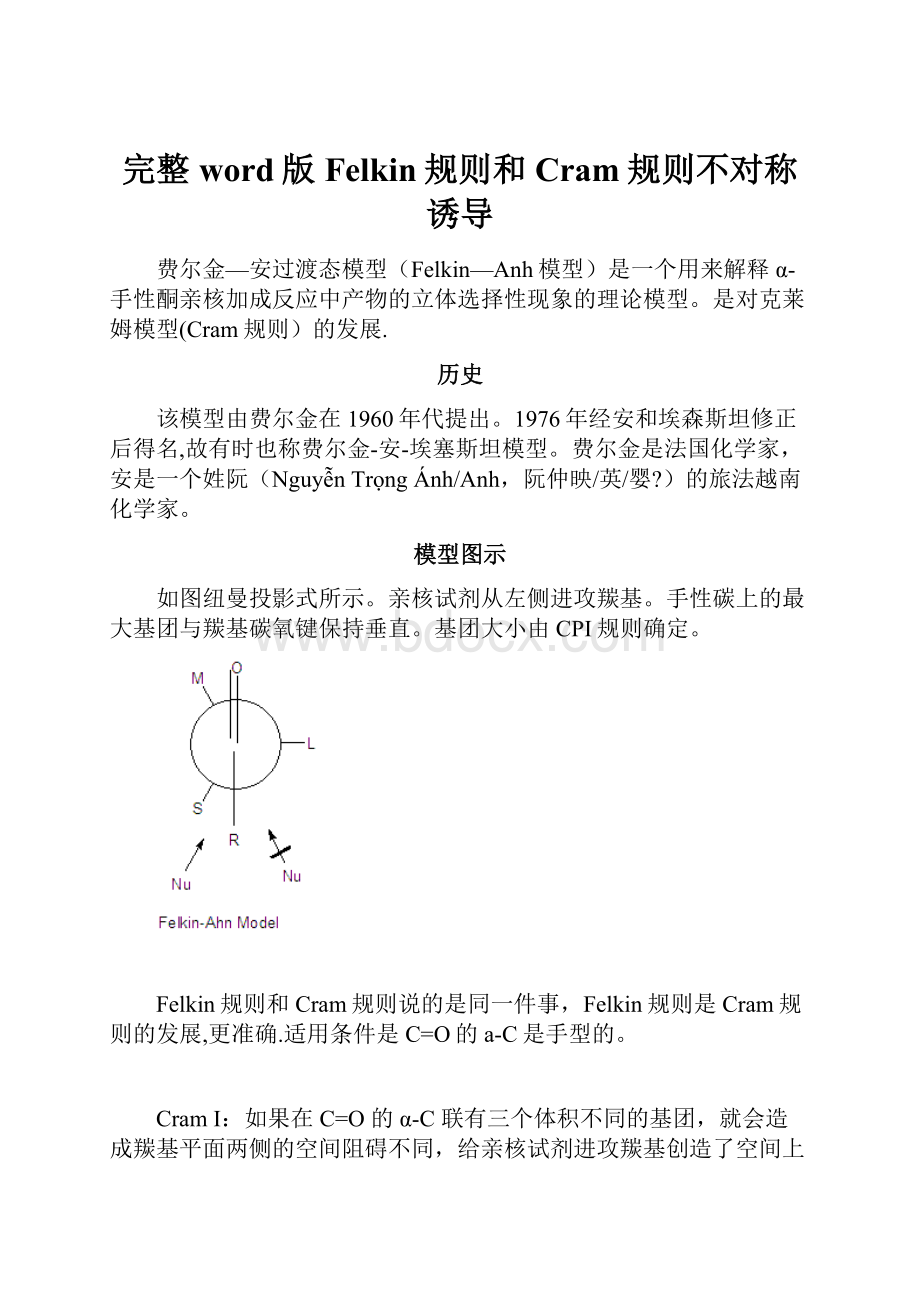完整word版Felkin规则和Cram规则不对称诱导.docx
《完整word版Felkin规则和Cram规则不对称诱导.docx》由会员分享,可在线阅读,更多相关《完整word版Felkin规则和Cram规则不对称诱导.docx(17页珍藏版)》请在冰豆网上搜索。

完整word版Felkin规则和Cram规则不对称诱导
费尔金—安过渡态模型(Felkin—Anh模型)是一个用来解释α-手性酮亲核加成反应中产物的立体选择性现象的理论模型。
是对克莱姆模型(Cram规则)的发展.
历史
该模型由费尔金在1960年代提出。
1976年经安和埃森斯坦修正后得名,故有时也称费尔金-安-埃塞斯坦模型。
费尔金是法国化学家,安是一个姓阮(NguyễnTrọngÁnh/Anh,阮仲映/英/婴?
)的旅法越南化学家。
模型图示
如图纽曼投影式所示。
亲核试剂从左侧进攻羰基。
手性碳上的最大基团与羰基碳氧键保持垂直。
基团大小由CPI规则确定。
Felkin规则和Cram规则说的是同一件事,Felkin规则是Cram规则的发展,更准确.适用条件是C=O的a-C是手型的。
CramI:
如果在C=O的α-C联有三个体积不同的基团,就会造成羰基平面两侧的空间阻碍不同,给亲核试剂进攻羰基创造了空间上的选择性,我们用L、M、S分别表示α-C上体积大、中、小的三个基团,规则如图所示。
CramII:
规则二适用于当α—C上有—OH,—NHR之类的基团从而和羰基氧形成氢键的情况。
本情况下,应该取重叠式构象为最稳构象,亲核试剂从S侧进攻。
Cram法则
Felkin—Ahn and Chelation Control
InFelkin-Ahnmodel,anucleophilecomesfromtheleasthinderedside。
ThebestwaytodoFelkin—Ahnmodelistodrawanewmenprojection。
Thenhavethenucleophileattackfromthesmallestgroup.
Felkin-Ahnmodelexample:
Here,themodelshowsthatthenucleophilepreferstoattackfromtheleasthinderedside。
ChelationControl:
InChelationControlthereisalwaysalewisbaseorlewisacidispresent。
Example:
LewisBasesareOR’,NR2’orSR'andlewisacidsareLi+,MgX+,Zn+2.Sincelewisbaseispresentthedoublebondedoxygenandlewisbaseformaringwithlewisacid.
ChelationControlexample:
NextslideshowsthatwhenaLewis—baseorLewis-Acidispresent,ChelationControlgivesthemajorproduct,byformingaringintransitionstateandFelkin—Ahnmodelsfails.
InGeneral:
HowtochoosebetweenFelkin-AhnandChelationControl:
Asymmetricinduction(alsoenantioinduction)instereochemistrydescribesthepreferentialformationinachemicalreactionofoneenantiomerordiastereoisomerovertheotherasaresultoftheinfluenceofachiralfeaturepresentinthesubstrate,reagent,catalystorenvironment。
[1]Asymmetricinductionisakeyelementinasymmetricsynthesis。
AsymmetricinductionwasintroducedbyHermannEmilFischerbasedonhisworkoncarbohydrates.[2]Severaltypesofinductionexist.
Internalasymmetricinductionmakesuseofachiralcenterboundtothereactivecenterthroughacovalentbondandremainssoduringthereaction。
Thestartingmaterialisoftenderivedfromchiralpoolsynthesis.Inrelayedasymmetricinductionthechiralinformationisintroducedinaseparatestepandremovedagaininaseparatechemicalreaction.Specialsynthonsarecalledchiralauxiliaries.Inexternalasymmetricinductionchiralinformationisintroducedinthetransitionstatethroughacatalystofchiralligand。
Thismethodofasymmetricsynthesisiseconomicallymostdesirable.
Contents
[hide]
∙1Carbonyl1,2asymmetricinduction
o1。
1Cram’srule
o1.2Felkinmodel
o1.3Felkin-Anhmodel
o1.4Anti–Felkinselectivity
∙2Carbonyl1,3asymmetricinduction
o2。
1Chelationmodel
o2。
2Non—chelationmodel
o2.3Cram–Reetzmodel
o2。
4Evansmodel
∙3Carbonyl1,2and1,3asymmetricinduction
∙4Acyclicalkenesasymmetricinduction
∙5Seealso
∙6References
∙7Externallinks
Carbonyl1,2asymmetricinduction[edit]
Severalmodelsexisttodescribechiralinductionatcarbonylcarbonsduringnucleophilicadditions。
Thesemodelsarebasedonacombinationofstericandelectronicconsiderationsandareofteninconflictwitheachother.ModelshavebeendevisedbyCram(1952),Cornforth(1959),Felkin(1969)andothers。
Cram’srule[edit]
TheCram’sruleofasymmetricinductiondevelopedbyDonaldJ。
Cramin1952[3]isanearlyconceptrelatingtothepredictionofstereochemistryincertainacyclicsystems.Infulltheruleis:
Incertainnon—catalyticreactionsthatdiastereomerwillpredominate,whichcouldbeformedbytheapproachoftheenteringgroupfromtheleasthinderedsidewhentherotationalconformationoftheC—Cbondissuchthatthedoublebondisflankedbythetwoleastbulkygroupsattachedtotheadjacentasymmetriccenter。
Theruleindicatesthatthepresenceofanasymmetriccenterinamoleculeinducestheformationofanasymmetriccenteradjacenttoitbasedonsterichindrance。
Inhis1952publicationCrampresentedalargenumberofreactionsdescribedintheliteratureforwhichtheconformationofthereactionproductscouldbeexplainedbasedonthisruleandhealsodescribedanelaborateexperiment(scheme1)makinghiscase.
Theexperimentsinvolvedtworeactions。
Inexperimentone2—phenylpropionaldehyde(1,racemicbut(R)—enantiomershown)wasreactedwiththeGrignardreagentofbromobenzeneto1,2-diphenyl—1—propanol
(2)asamixtureofdiastereomers,predominantlythethreoisomer(seeforexplanationtheFischerprojection)。
Thepreferencefortheformationofthethreoisomercanbeexplainedbytherulestatedabovebyhavingtheactivenucleophileinthisreactionattackingthecarbonylgroupfromtheleasthinderedside(seeNewmanprojectionA)whenthecarbonylispositionedinastaggeredformationwiththemethylgroupandthehydrogenatom,whicharethetwosmallestsubstituentscreatingaminimumofsterichindrance,inagaucheorientationandphenylasthemostbulkygroupintheanticonformation.
Thesecondreactionistheorganicreductionof1,2—diphenyl-1—propanone2withlithiumaluminiumhydride,whichresultsinthesamereactionproductasabovebutnowwithpreferencefortheerythroisomer(2a).Nowahydrideanion(H−)isthenucleophileattackingfromtheleasthinderedside(imaginehydrogenenteringfromthepaperplane)。
Intheoriginal1952publication,additionalevidencewasobtainedforthestructuralassignmentofthereactionproductsbyapplyingthemtoaChugaevelimination,whereinthethreoisomerreactstothecisisomerof-α-methyl-stilbeneandtheerythroisomertothetransversion。
Felkinmodel[edit]
TheFelkinmodel(1968)namedafterHughFelkinalsopredictsthestereochemistryofnucleophilicadditionreactionstocarbonylgroups。
[4]FelkinarguedthattheCrammodelsufferedamajordrawback:
aneclipsedconformationinthetransitionstatebetweenthecarbonylsubstituent(thehydrogenatominaldehydes)andthelargestα—carbonylsubstituent。
Hedemonstratedthatbyincreasingthestericbulkofthecarbonylsubstituentfrommethyltoethyltoisopropyltoisobutyl,thestereoselectivityalsoincreased,whichisnotpredictedbyCram'srule:
TheFelkinrulesare:
∙Thetransitionstatesarereactant-like.
∙Torsionalstrain(Pitzerstrain)involvingpartialbonds(intransitionstates)representsasubstantialfractionofthestrainbetweenfullyformedbonds,evenwhenthedegreeofbondingisquitelow.TheconformationintheTSisstaggeredandnoteclipsedwiththesubstituentRskewwithrespecttotwoadjacentgroupsoneofthemthesmallestinTSA.
ForcomparisonTSBistheCramtransitionstate.
∙ThemainstericinteractionsinvolvethosearoundRandthenucleophilebutnotthecarbonyloxygenatom。
∙Apolareffectorelectroniceffectstabilizesatransitionstatewithmaximumseparationbetweenthenucleophileandanelectron—withdrawinggroup.ForinstancehaloketonesdonotobeyCram’srule,and,intheexampleabove,replacingtheelectron-withdrawingphenylgroupbyacyclohexylgroupreducesstereoselectivityconsiderably.
Felkin—Anhmodel[edit]
TheFelkin-Anhmodel[5]isanextensionoftheFelkinmodelthatincorporatesimprovementssuggestedbyNguyenT.AnhandO。
EisensteintocorrectfortwokeyweaknessesinFelkin'smodel.ThefirstweaknessaddressedwasthestatementbyFelkinofastrongpolareffectinnucleophilicadditiontransitionstates,whichleadstothecompleteinversionofstereochemistrybySN2reactions,withoutofferingjustificationsastowhythisphenomenonwasobserved.Anh’ssolutionwastooffertheantiperiplanareffectasaconsequenceofasymmetricinductionbeingcontrolledbybothsubstituentandorbitaleffects.[6][7]Inthiseffect,thebestnucleophileacceptorσ*orbitalisalignedparalleltoboththeπandπ*orbitalsofthecarbonyl,whichprovidestabilizationoftheincominganion.
ThesecondweaknessintheFelkinModelwastheassumptionofsubstituentminimizationaroundthecarbonylR,whichcannotbeappliedtoaldehydes.
IncorporationofBürgi–Dunitzangle[8][9]ideasallowedAnhtopostulateanon-perpendicularattackbythenucleophileonthecarbonylcenter,anywherefrom95°to105°relativetotheoxygen-carbondoublebond,favoringapproachclosertothesmallersubstituentandtherebysolvetheproblemofpredictabilityforaldehydes.[6][10][11]
Anti–Felkinselectivity[edit]
ThoughtheCramandFelkin–Anhmodelsdifferintheconformersconsideredandotherassumptions,theybothattempttoexplainthesamebasicphenomenon:
thepreferentialadditionofanucleophiletothemoststericallyfavoredfaceofacarbonylmoiety.However,manyexamplesexistofreactionsthatdisplaystereoselectivityoppositeofwhatispredictedbythebasictenetsoftheCramandFelkin–Anhmodels。
Althoughbothofthemodelsincludeattemptstoexplainthesereversals,theproductsobtainedarestillreferredtoas"anti-Felkin"products。
Oneofthemostcommonexamplesofalteredasymmetricinductionselectivityrequiresanα-carbonsubstitutedwithacomponentwithLewisbasecharacter(i。
e.O,N,S,Psubstituents).Inthissituation,ifaLewisacidsuchasAl-iPr2orZn2+isintroduced,abidentatechelationeffectcanbeobserved。
ThislocksthecarbonylandtheLewisbasesubstituentinaneclipsedconformation,andthenucleophilewillthenattackfromthesidewiththesmallestfreeα—carbonsubstituent.[12]IfthechelatingRgroupisidentifiedasthelargest,thiswillresultinan”anti—Felkin"product.
ThisstereoselectivecontrolwasrecognizedanddiscussedinthefirstpaperestablishingtheCrammodel,causingCramtoassertthathismodelrequiresnon-chelatingconditions.[13]Anexampleofchelationcontrolofareactioncanbeseenhere,froma1987paperthatwasthefi